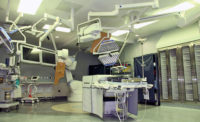Jim Godfrey, managing director of Perkins+Will’s Charlotte, N.C., office, says some health systems are planning more medical office buildings and outpatient facilities to accommodate primary care needs. Perkins+Will recently designed an ambulatory-care operating room expansion for University of North Carolina Hospitals at its Chapel Hill campus.
In Orlando, Turner is busy with two design-build medical office building projects, a $1.2-million, 7,500-sq-ft center for an orthopedic surgeon and a $335,000, 2,000-sq-ft interior and exterior renovation job for a primary-care physician.
Turner also is working on the new 13,000-sq-ft Lillian S. Wells Foundation Women’s Health Center at Broward General Medical Center in Fort Lauderdale and in a separate project for Broward Health, a catheterization lab at the same hospital.
The uncertainty surround health care during the national legislative initiative impacted the market, Noli says.
“The ticking legislation derailed a number of projects because hospitals were concerned about what could be passed in the bill,” he says. “Since the legislation has passed, hospitals have gotten a more complete picture of reimbursement in the future, and that may be responsible for the release of jobs in the last number of months.”
Hank Adams, a vice president and health-care principal at HDR in Dallas, agrees that private-sector hospitals continue to take a “wait-and-see” approach to how health reform will affect reimbursement. They are still master planning for the coming 10 to 15 years but are conservative about committing to construction projects, he says.
HDR is completing a master plan and design of a children’s specialty facility at Pitt County Memorial Hospital in Greenville, N.C. Construction is scheduled to begin on the pediatric hospital in 2011.
Johnson at Perkins+Will also reports more master planning, including reviews of operations.
Greening in the Marketplace
Johnson says sustainability has become a standard in the industry.
“It’s becoming an element in our construction programs that doesn’t have a premium associated with it anymore,” Johnson says.
Godfrey adds, “We’ve had clients doing major additions wanting them to be LEED certified or higher. We’re getting more questions about it and the far reaches of green, like solar.”
Some of Godfrey’s clients want the sustainable features, even if they do not pursue LEED. However, he says that North Carolina is considering adding sustainability requirements to its certificate-of-need application.
Perkins+Will’s $131-million, 219,000-sq-ft, three-story Moses H. Cone Memorial Hospital North Tower Expansion Project in Greensboro, N.C., aims for LEED-Silver certification. The addition will add patient beds, replace the surgical suites and double the size of the emergency department.
Memorial Healthcare System’s planned LEED-Silver Joe DiMaggio Children’s Hospital expansion in Hollywood, Fla., topped out in May. ANF Group of Cooper City, Fla., is building the $84.3-million, 160,000-sq-ft, four-story facility, and Stanley Beaman & Sears of Atlanta designed it. The project in total will cost $135.6 million and bring the hospital’s bed count to 204.
Brownrigg says bond buyers have become more interested in the long-term operational cost and lifecycle costs, contributing to more green building.
“Sustainability from an operational cost-benefit perspective is becoming more predominant because the financial markets are questioning the long-term viability,” he says.
More Projects
Morette Co. of Pensacola, Fla., broke ground in July on a $24-million expansion at Baptist Hospital of Pensacola. Designed by George Koper Associates of Pensacola, the new facility adds operating rooms, a progressive-care unit and waiting areas.
Baptist Health Care is also expanding its Gulf Breeze Hospital, with a $5-million project to add intensive-care beds, private patient rooms and an inpatient physical therapy gym.









Post a comment to this article
Report Abusive Comment